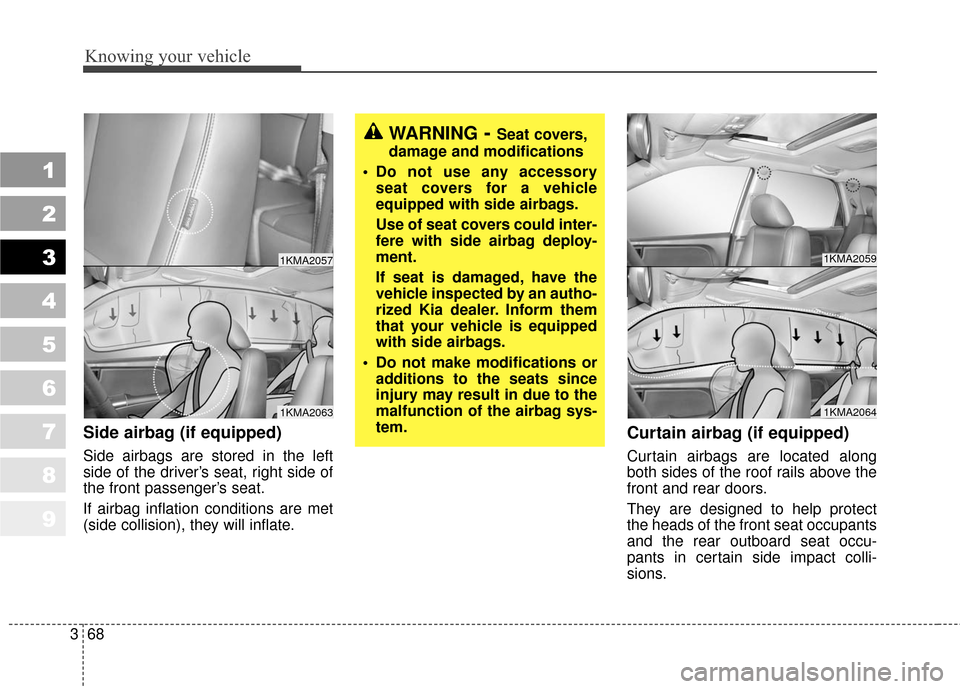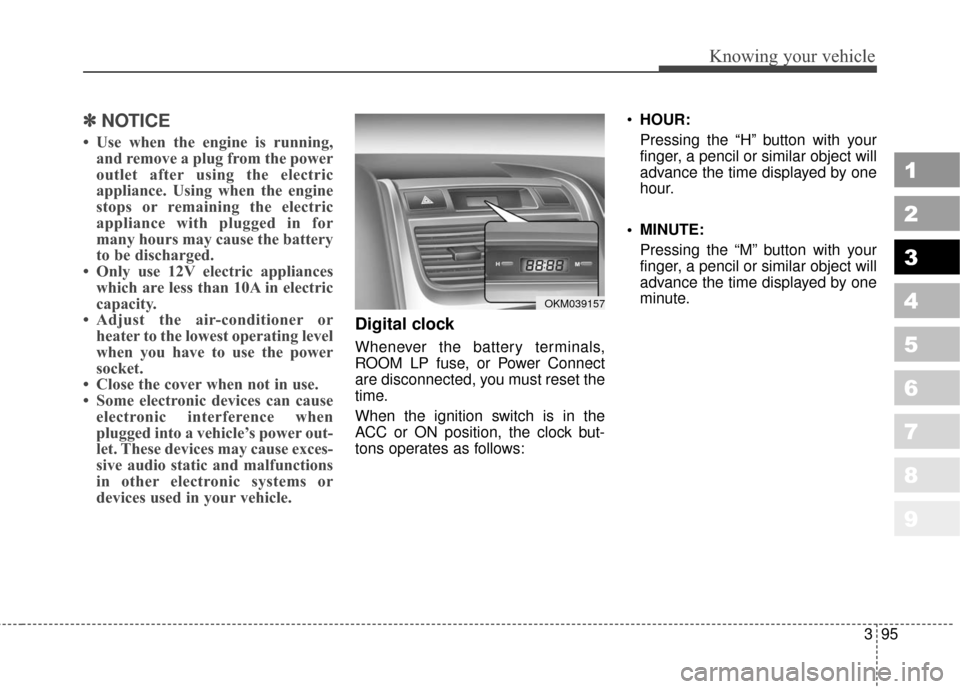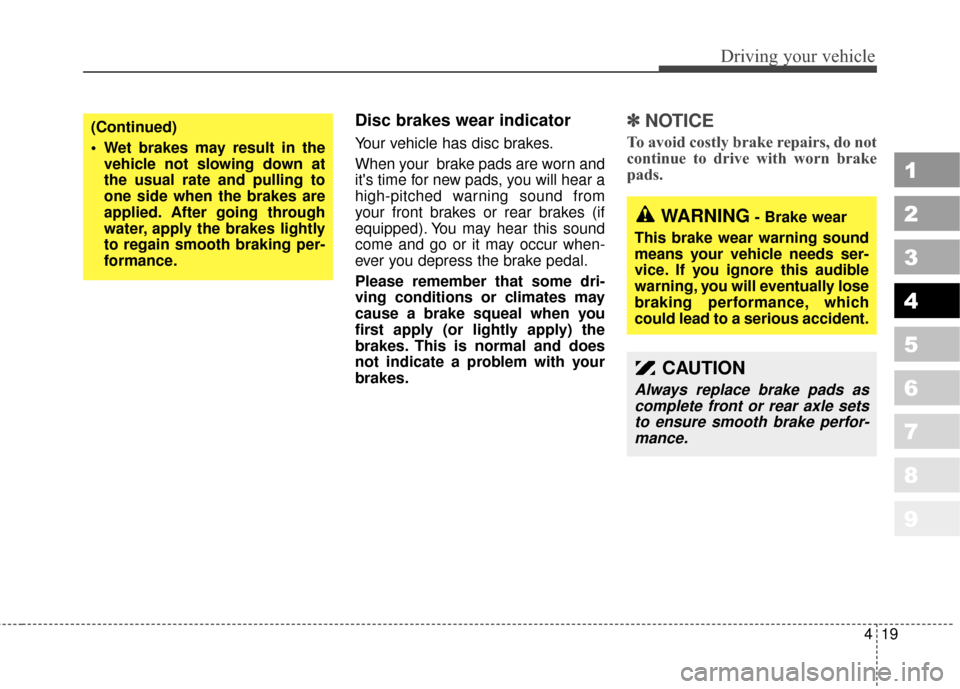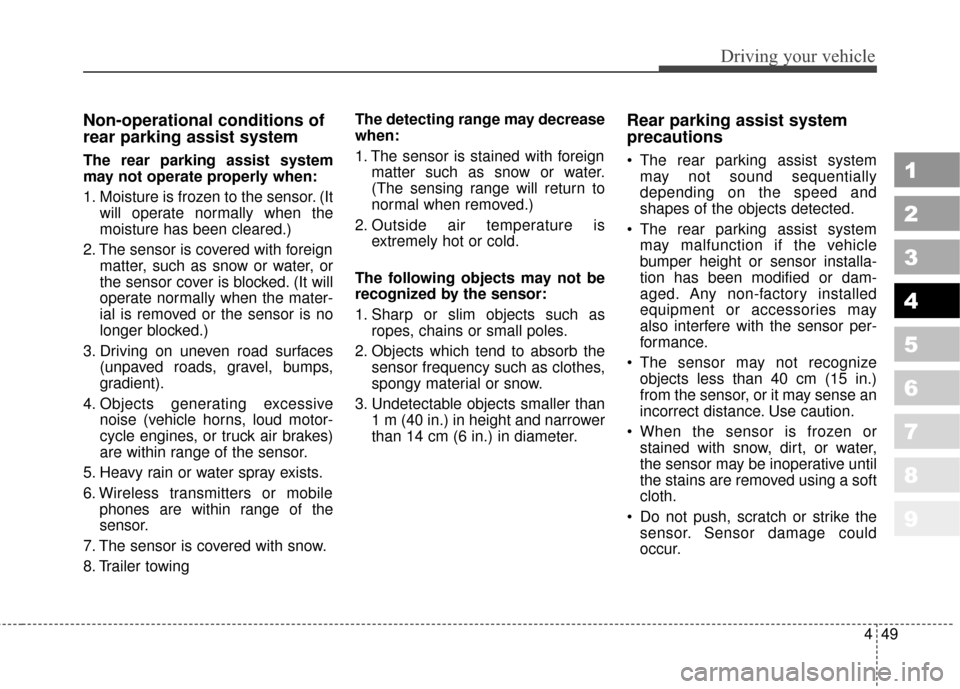Page 77 of 371

Knowing your vehicle
68
3
1
2
3
4
5
6
7
8
9
Side airbag (if equipped)
Side airbags are stored in the left
side of the driver’s seat, right side of
the front passenger’s seat.
If airbag inflation conditions are met
(side collision), they will inflate.
Curtain airbag (if equipped)
Curtain airbags are located along
both sides of the roof rails above the
front and rear doors.
They are designed to help protect
the heads of the front seat occupants
and the rear outboard seat occu-
pants in certain side impact colli-
sions.
WARNING- Seat covers,
damage and modifications
Do not use any accessory seat covers for a vehicle
equipped with side airbags.
Use of seat covers could inter-
fere with side airbag deploy-
ment.
If seat is damaged, have the
vehicle inspected by an autho-
rized Kia dealer. Inform them
that your vehicle is equipped
with side airbags.
Do not make modifications or additions to the seats since
injury may result in due to the
malfunction of the airbag sys-
tem.
1KMA2063
1KMA20571KMA2059
1KMA2064
Page 80 of 371

371
1
2
3
4
5
6
7
8
9
Knowing your vehicle
Airbag inflation condition
Front airbag
Front airbags are designed to inflate
when the impact is delivered to front
collision sensors depending on the
intensity, speed or angles of impact
of the front collision - generally from
an area a little to the left to a little to
the right of straight ahead.
WARNING- Protecting
airbag module and sensors
Do not hit or allow any heavy objects to hit the locations
where airbags or sensors are
installed.
This may cause damage and
unexpected airbag deploy-
ment, which could result in
serious personal injury or
death.
If the installation location or angle of the sensors is altered
in any way, the airbags may
malfunction, causing severe
injury or death.
Therefore, do not try to per-
form maintenance on or
around the airbag sensors.
Have the vehicle repaired by
an authorized Kia dealer.WARNING- Body
changes
Problems may arise if the sen- sor installation angles are
changed due to the deforma-
tion of front bumper, body or B
pillar where side collision sen-
sors are installed. In the event
of a collision, have the vehicle
inspected by an authorized
Kia dealer.
Your vehicle has been designed to deploy the
airbag(s) in certain collisions.
Installing aftermarket bumper
guards or replacing a bumper
with non-genuine parts may
adversely affect your vehicle’s
airbag deployment perfor-
mance.
1VQA2084
Page 81 of 371
Knowing your vehicle
72
3
1
2
3
4
5
6
7
8
9
Side airbag
Side airbags (side and curtain
airbags) are designed to inflate
depending on the strength, speed
and angles of impact of a side impact
collision or rollover. If the vehicle chassis is impacted by
bumps or objects on unimproved
roads or sidewalks, airbags may
deploy. Drive carefully on unim-
proved roads or on surfaces not
designed for vehicle traffic to prevent
unintended airbag deployment.
Airbag non-inflation conditions
In certain low-speed collisions the
airbags may not deploy. The
airbags are designed not to deploy
in such cases because the risk of
injuries which can be caused by
the airbags exceeds the benefits
they provide in protecting occu-
pants.
OVQ036018N
1KMB2064
1VQA2086
Page 104 of 371

395
1
2
3
4
5
6
7
8
9
Knowing your vehicle
✽ ✽NOTICE
• Use when the engine is running,
and remove a plug from the power
outlet after using the electric
appliance. Using when the engine
stops or remaining the electric
appliance with plugged in for
many hours may cause the battery
to be discharged.
• Only use 12V electric appliances which are less than 10A in electric
capacity.
• Adjust the air-conditioner or heater to the lowest operating level
when you have to use the power
socket.
• Close the cover when not in use.
• Some electronic devices can cause electronic interference when
plugged into a vehicle’s power out-
let. These devices may cause exces-
sive audio static and malfunctions
in other electronic systems or
devices used in your vehicle.
Digital clock
Whenever the battery terminals,
ROOM LP fuse, or Power Connect
are disconnected, you must reset the
time.
When the ignition switch is in the
ACC or ON position, the clock but-
tons operates as follows:
HOUR:
Pressing the “H” button with your
finger, a pencil or similar object will
advance the time displayed by one
hour.
MINUTE: Pressing the “M” button with your
finger, a pencil or similar object will
advance the time displayed by one
minute.
OKM039157
Page 166 of 371

419
Driving your vehicle
1
2
3
4
5
6
7
8
9
Disc brakes wear indicator
Your vehicle has disc brakes.
When your brake pads are worn and
it's time for new pads, you will hear a
high-pitched warning sound from
your front brakes or rear brakes (if
equipped). You may hear this sound
come and go or it may occur when-
ever you depress the brake pedal.
Please remember that some dri-
ving conditions or climates may
cause a brake squeal when you
first apply (or lightly apply) the
brakes. This is normal and does
not indicate a problem with your
brakes.
✽ ✽NOTICE
To avoid costly brake repairs, do not
continue to drive with worn brake
pads.
WARNING- Brake wear
This brake wear warning sound
means your vehicle needs ser-
vice. If you ignore this audible
warning, you will eventually lose
braking performance, which
could lead to a serious accident.
CAUTION
Always replace brake pads as complete front or rear axle setsto ensure smooth brake perfor-mance.
(Continued)
Wet brakes may result in the vehicle not slowing down at
the usual rate and pulling to
one side when the brakes are
applied. After going through
water, apply the brakes lightly
to regain smooth braking per-
formance.
Page 196 of 371

449
Driving your vehicle
Non-operational conditions of
rear parking assist system
The rear parking assist system
may not operate properly when:
1. Moisture is frozen to the sensor. (Itwill operate normally when the
moisture has been cleared.)
2. The sensor is covered with foreign matter, such as snow or water, or
the sensor cover is blocked. (It will
operate normally when the mater-
ial is removed or the sensor is no
longer blocked.)
3. Driving on uneven road surfaces (unpaved roads, gravel, bumps,
gradient).
4. Objects generating excessive noise (vehicle horns, loud motor-
cycle engines, or truck air brakes)
are within range of the sensor.
5. Heavy rain or water spray exists.
6. Wireless transmitters or mobile phones are within range of the
sensor.
7. The sensor is covered with snow.
8. Trailer towing The detecting range may decrease
when:
1. The sensor is stained with foreign
matter such as snow or water.
(The sensing range will return to
normal when removed.)
2. Outside air temperature is extremely hot or cold.
The following objects may not be
recognized by the sensor:
1. Sharp or slim objects such as ropes, chains or small poles.
2. Objects which tend to absorb the sensor frequency such as clothes,
spongy material or snow.
3. Undetectable objects smaller than 1 m (40 in.) in height and narrower
than 14 cm (6 in.) in diameter.
Rear parking assist system
precautions
The rear parking assist systemmay not sound sequentially
depending on the speed and
shapes of the objects detected.
The rear parking assist system may malfunction if the vehicle
bumper height or sensor installa-
tion has been modified or dam-
aged. Any non-factory installed
equipment or accessories may
also interfere with the sensor per-
formance.
The sensor may not recognize objects less than 40 cm (15 in.)
from the sensor, or it may sense an
incorrect distance. Use caution.
When the sensor is frozen or stained with snow, dirt, or water,
the sensor may be inoperative until
the stains are removed using a soft
cloth.
Do not push, scratch or strike the sensor. Sensor damage could
occur.1
2
3
4
5
6
7
8
9
Page 210 of 371
463
Driving your vehicle
1
2
3
4
5
6
7
8
9
1. Fan speed control knob
2. Mode selection knob
3. Temperature control knob
4. Air conditioning button (if equipped)
5. Air intake control button
6. Rear window defroster button (if equipped)Fan speed control knob
The ignition switch must be in the ON
position for fan operation.
The fan speed control knob allows
you to control the fan speed of the air
flowing from the ventilation system.
To change the fan speed, turn the
knob to the right for higher speed or
left for lower speed.
Setting the mode selection knob to
the “0” position turns off the fan.
Temperature control knob
The temperature control knob allows
you to control the temperature of the
air flowing from the ventilation sys-
tem. To change the air temperature in
the passenger compartment, turn
the knob to the right for warm and
hot air or left for cooler air.
MANUAL CLIMATE CONTROL SYSTEM (IF EQUIPPED)
OKM049136OKM049134OKM029130
Page 214 of 371

467
Driving your vehicle
1
2
3
4
5
6
7
8
9
It should be noted that prolonged
operation of the heating in recir-
culated air position will cause fog-
ging of the windshield and side
windows and the air within the
passenger compartment will
become stale.
In addition, prolonged use of the
air conditioning with the “recircu-
lated air position” selected, will
result in excessively dry air in the
passenger compartment.
Air conditioning button
(if equipped)
Push the A/C button to turn the air
conditioning system on (indicator
light will illuminate). Push the button
again to turn the air conditioning sys-
tem off.
WARNING - Recirculated
air
Continued use of the climate control system operation in
the recirculated air position
may allow humidity to
increase inside vehicle which
may fog the glass and
obscure visibility.
Continued use of the climate control system operation in
the recirculated air position
can result in somewhat
reduced oxygen levels, caus-
ing drowsiness or sleepiness,
and loss of vehicle control.
Set the air intake control to
the outside (fresh) air position
as much as possible while dri-
ving.
OKM049137